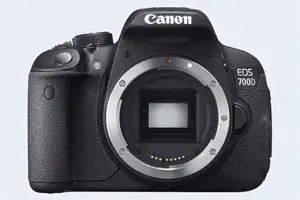Canon 700D vs R7
The Canon EOS 700D (called Canon T5i in some regions) and the Canon EOS R7 are two digital cameras that were officially introduced, respectively, in March 2013 and May 2022. The 700D is a DSLR, while the R7 is a mirrorless interchangeable lens camera. Both cameras are equipped with an APS-C sensor. The 700D has a resolution of 17.9 megapixels, whereas the R7 provides 32.3 MP.
Below is an overview of the main specs of the two cameras as a starting point for the comparison.

Check 700D offers at
ebay.com

Check R7 price at
amazon.com
Going beyond this snapshot of core features and characteristics, what are the differences between the Canon EOS 700D and the Canon EOS R7? Which one should you buy? Read on to find out how these two cameras compare with respect to their body size, their imaging sensors, their shooting features, their input-output connections, and their reception by expert reviewers.
Body comparison
The side-by-side display below illustrates the physical size and weight of the Canon 700D and the Canon R7. The two cameras are presented according to their relative size. Three consecutive perspectives from the front, the top, and the back are available. All size dimensions are rounded to the nearest millimeter.
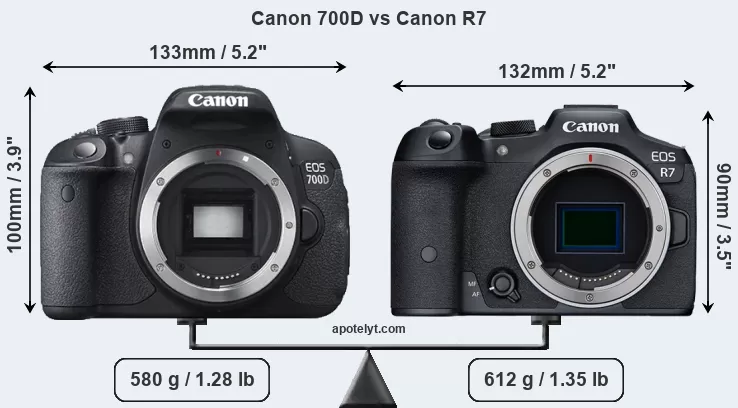
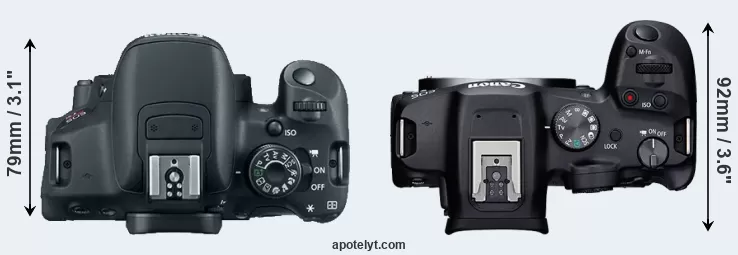
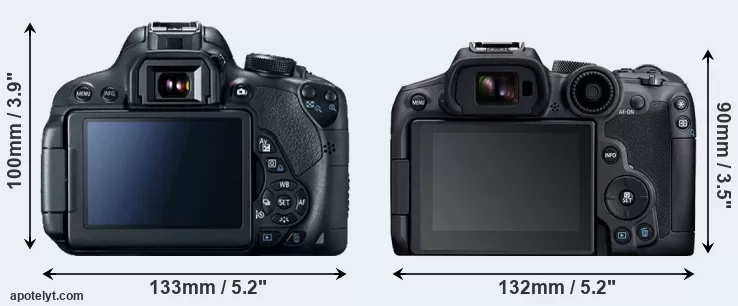
If the front view area (width x height) of the cameras is taken as an aggregate measure of their size, the Canon R7 is notably smaller (11 percent) than the Canon 700D. However, the R7 is markedly heavier (6 percent) than the 700D. It is noteworthy in this context that the R7 is splash and dust-proof, while the 700D does not feature any corresponding weather-sealing.
The above size and weight comparisons are to some extent incomplete since they do not consider the interchangeable lenses that both of these cameras require. Hence, you might want to study and compare the specifications of available lenses in order to get the full picture of the size and weight of the two camera systems.
Concerning battery life, the 700D gets 440 shots out of its Canon LP-E8 battery, while the R7 can take 660 images on a single charge of its Canon LP-E6NH power pack. The power pack in the R7 can be charged via the USB port, which can be very convenient when travelling.
The table below summarizes the key physical specs of the two cameras alongside a broader set of comparators. In case you want to display and compare another camera duo, you can use the CAM-parator app to select your camera combination among a large number of options.

| Camera Model |
Camera Width |
Camera Height |
Camera Depth |
Camera Weight |
Battery Life |
Weather Sealing |
Camera Launch |
Launch Price (USD) |
Street Price |
||
|---|---|---|---|---|---|---|---|---|---|---|---|
| 1. | Canon 700D | 133 mm | 100 mm | 79 mm | 580 g | 440 | n | Mar 2013 | 649 | ebay.com | |
| 2. | Canon R7 | 132 mm | 90 mm | 92 mm | 612 g | 660 | Y | May 2022 | 1,499 | amazon.com | |
| 3. | Canon 100D | 117 mm | 91 mm | 69 mm | 407 g | 380 | n | Mar 2013 | 549 | ebay.com | |
| 4. | Canon 500D | 129 mm | 98 mm | 62 mm | 520 g | 400 | n | Mar 2009 | 799 | ebay.com | |
| 5. | Canon 550D | 129 mm | 98 mm | 62 mm | 530 g | 440 | n | Feb 2010 | 699 | ebay.com | |
| 6. | Canon 600D | 133 mm | 100 mm | 80 mm | 570 g | 440 | n | Feb 2011 | 599 | ebay.com | |
| 7. | Canon 650D | 133 mm | 100 mm | 79 mm | 575 g | 440 | n | Jun 2012 | 849 | ebay.com | |
| 8. | Canon 750D | 132 mm | 101 mm | 78 mm | 555 g | 440 | n | Feb 2015 | 749 | ebay.com | |
| 9. | Canon 760D | 132 mm | 101 mm | 78 mm | 565 g | 440 | n | Feb 2015 | 649 | ebay.com | |
| 10. | Canon 1200D | 130 mm | 100 mm | 78 mm | 480 g | 500 | n | Feb 2014 | 449 | ebay.com | |
| 11. | Canon G7 X | 103 mm | 60 mm | 40 mm | 304 g | 210 | n | Sep 2014 | 699 | ebay.com | |
| 12. | Canon M | 109 mm | 66 mm | 32 mm | 298 g | 230 | n | Jul 2012 | 599 | ebay.com | |
| 13. | Canon R6 Mark II | 138 mm | 98 mm | 88 mm | 670 g | 450 | Y | Nov 2022 | 2,499 | amazon.com | |
| 14. | Fujifilm X-T5 | 130 mm | 91 mm | 64 mm | 557 g | 580 | Y | Nov 2022 | 1,699 | amazon.com | |
| 15. | Panasonic GH5 II | 139 mm | 98 mm | 87 mm | 727 g | 400 | Y | May 2021 | 1,699 | amazon.com | |
| 16. | Sony A7 IV | 131 mm | 96 mm | 80 mm | 659 g | 580 | Y | Oct 2021 | 2,499 | amazon.com | |
| 17. | Sony A7C II | 124 mm | 71 mm | 63 mm | 514 g | 540 | Y | Aug 2023 | 2,199 | amazon.com | |
| Note: Measurements and pricing do not include easily detachable parts, such as add-on or interchangeable lenses or optional viewfinders. | |||||||||||
Any camera decision will naturally be influenced heavily by the price. The manufacturer’s suggested retail prices give an idea on the placement of the camera in the maker’s lineup and the broader market. The 700D was launched at a markedly lower price (by 57 percent) than the R7, which puts it into a different market segment. Normally, street prices remain initially close to the MSRP, but after a couple of months, the first discounts appear. Later in the product cycle and, in particular, when the replacement model is about to appear, further discounting and stock clearance sales often push the camera price considerably down. Then, after the new model is out, very good deals can frequently be found on the pre-owned market.
Sensor comparison
The size of the sensor inside a digital camera is one of the key determinants of image quality. All other things equal, a large sensor will have larger individual pixel-units that offer better low-light sensitivity, wider dynamic range, and richer color-depth than smaller pixels in a sensor of the same technological generation. Moreover, a large sensor camera will give the photographer more control over depth-of-field in the image and, thus, the ability to better isolate a subject from the background. On the downside, larger sensors tend to be more expensive and lead to bigger and heavier cameras and lenses.
Both cameras under consideration feature an APS-C sensor, but their sensors differ slightly in size. The sensor area in the R7 is 1 percent smaller. They nevertheless have the same format factor of 1.6. Both cameras have a native aspect ratio (sensor width to sensor height) of 3:2.
Technology-wise, the R7 uses a more advanced image processing engine (DIGIC X) than the 700D (DIGIC 5), with benefits for noise reduction, color accuracy, and processing speed.
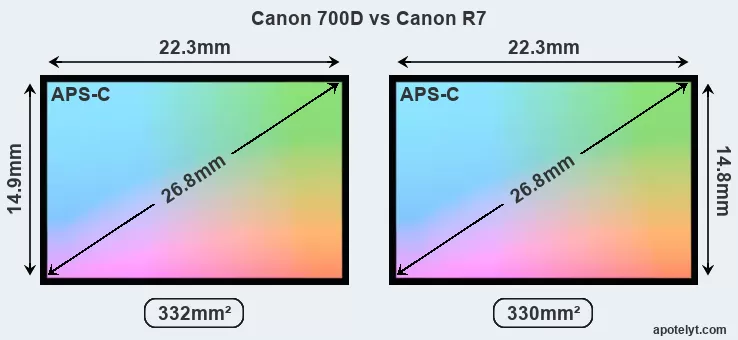
Despite having a slightly smaller sensor, the R7 offers a higher resolution of 32.3 megapixels, compared with 17.9 MP of the 700D. This megapixels advantage comes at the cost of a higher pixel density and a smaller size of the individual pixel (with a pixel pitch of 3.20μm versus 4.31μm for the 700D). However, it should be noted that the R7 is much more recent (by 9 years and 2 months) than the 700D, and its sensor will have benefitted from technological advances during this time that make it possible to gather light more efficiently.
The resolution advantage of the Canon R7 implies greater flexibility for cropping images or the possibility to print larger pictures. The maximum print size of the R7 for good quality output (200 dots per inch) amounts to 34.8 x 23.2 inches or 88.4 x 58.9 cm, for very good quality (250 dpi) 27.8 x 18.6 inches or 70.7 x 47.1 cm, and for excellent quality (300 dpi) 23.2 x 15.5 inches or 58.9 x 39.3 cm. The corresponding values for the Canon 700D are 25.9 x 17.3 inches or 65.8 x 43.9 cm for good quality, 20.7 x 13.8 inches or 52.7 x 35.1 cm for very good quality, and 17.3 x 11.5 inches or 43.9 x 29.3 cm for excellent quality prints.
The Canon EOS 700D has a native sensitivity range from ISO 100 to ISO 12800, which can be extended to ISO 100-25600. The corresponding ISO settings for the Canon EOS R7 are ISO 100 to ISO 32000, with the possibility to increase the ISO range to 100-51200.
Technology-wise, both cameras are equipped with CMOS (Complementary Metal–Oxide–Semiconductor) sensors. Both cameras use a Bayer filter for capturing RGB colors on a square grid of photosensors. This arrangement is found in most digital cameras.
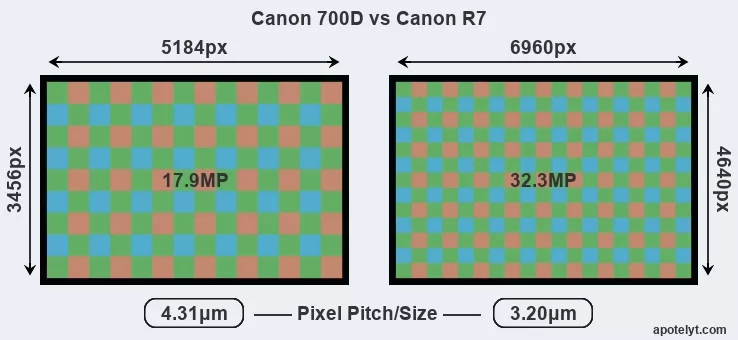
Since 2007, DXO Mark has published sensor performance measurements that have been derived using a consistent methodology. This service assesses and scores the color depth ("DXO Portrait"), dynamic range ("DXO Landscape"), and low-light sensitivity ("DXO Sports") of camera sensors, and also publishes an overall camera score. The table below summarizes the physical sensor characteristics and sensor quality findings and compares them across a set of similar cameras.

| Camera Model |
Sensor Class |
Resolution (MP) |
Horiz. Pixels |
Vert. Pixels |
Video Format |
DXO Portrait |
DXO Landscape |
DXO Sports |
DXO Overall |
||
|---|---|---|---|---|---|---|---|---|---|---|---|
| 1. | Canon 700D | APS-C | 17.9 | 5184 | 3456 | 1080/30p | 21.7 | 11.2 | 681 | 61 | |
| 2. | Canon R7 | APS-C | 32.3 | 6960 | 4640 | 4k/60p | 24.1 | 13.8 | 2092 | 84 | |
| 3. | Canon 100D | APS-C | 17.9 | 5184 | 3456 | 1080/30p | 21.8 | 11.3 | 843 | 63 | |
| 4. | Canon 500D | APS-C | 15.1 | 4752 | 3168 | 1080/20p | 21.7 | 11.5 | 663 | 63 | |
| 5. | Canon 550D | APS-C | 17.9 | 5184 | 3456 | 1080/30p | 22.1 | 11.5 | 784 | 66 | |
| 6. | Canon 600D | APS-C | 17.9 | 5184 | 3456 | 1080/30p | 22.1 | 11.5 | 793 | 65 | |
| 7. | Canon 650D | APS-C | 17.9 | 5184 | 3456 | 1080/30p | 21.7 | 11.2 | 722 | 62 | |
| 8. | Canon 750D | APS-C | 24.0 | 6000 | 4000 | 1080/30p | 22.7 | 12.0 | 919 | 71 | |
| 9. | Canon 760D | APS-C | 24.0 | 6000 | 4000 | 1080/30p | 22.6 | 12.0 | 915 | 70 | |
| 10. | Canon 1200D | APS-C | 17.9 | 5184 | 3456 | 1080/30p | 21.9 | 11.3 | 724 | 63 | |
| 11. | Canon G7 X | 1-inch | 20.0 | 5472 | 3648 | 1080/60p | 23.0 | 12.7 | 556 | 71 | |
| 12. | Canon M | APS-C | 17.9 | 5184 | 3456 | 1080/30p | 22.1 | 11.2 | 827 | 65 | |
| 13. | Canon R6 Mark II | Full Frame | 24.0 | 6000 | 4000 | 4k/60p | 25.4 | 14.6 | 3154 | 96 | |
| 14. | Fujifilm X-T5 | APS-C | 39.8 | 7728 | 5152 | 6.2k/30p | 24.3 | 13.9 | 2264 | 86 | |
| 15. | Panasonic GH5 II | Four Thirds | 20.2 | 5184 | 3888 | 4K/60p | 23.7 | 13.1 | 1136 | 79 | |
| 16. | Sony A7 IV | Full Frame | 32.7 | 7008 | 4672 | 4K/60p | 25.4 | 14.7 | 3379 | 97 | |
| 17. | Sony A7C II | Full Frame | 32.7 | 7008 | 4672 | 4K/60p | 25.4 | 14.7 | 3237 | 96 | |
| Note: DXO values in italics represent estimates based on sensor size and age. | |||||||||||
Many modern cameras are not only capable of taking still images, but can also record movies. The two cameras under consideration both have sensors whose read-out speed is fast enough to capture moving pictures, but the R7 provides a better video resolution than the 700D. It can shoot movie footage at 4k/60p, while the 700D is limited to 1080/30p.
Feature comparison
Apart from body and sensor, cameras can and do differ across a range of features. For example, the R7 has an electronic viewfinder (2360k dots), while the 700D has an optical one. Both systems have their advantages, with the electronic viewfinder making it possible to project supplementary shooting information into the framing view, whereas the optical viewfinder offers lag-free viewing and a very clear framing image. The viewfinder in the R7 offers a wider field of view (100%) than the one in the 700D (95%), so that a larger proportion of the captured image is visible in the finder. In addition, the viewfinder of the R7 has a higher magnification (0.72x vs 0.53x), so that the size of the image transmitted appears closer to the size seen with the naked human eye. The adjacent table lists some of the other core features of the Canon 700D and Canon R7 along with similar information for a selection of comparators.

| Camera Model |
Viewfinder (Type or 000 dots) |
Control Panel (yes/no) |
LCD Specifications (inch/000 dots) |
LCD Attach- ment |
Touch Screen (yes/no) |
Max Shutter Speed * |
Max Shutter Flaps * |
Built-in Flash (yes/no) |
Built-in Image Stab |
||
|---|---|---|---|---|---|---|---|---|---|---|---|
| 1. | Canon 700D | optical | n | 3.0 / 1040 | swivel | Y | 1/4000s | 5.0/s | Y | n | |
| 2. | Canon R7 | 2360 | n | 3.0 / 1620 | swivel | Y | 1/8000s | 15.0/s | n | Y | |
| 3. | Canon 100D | optical | n | 3.0 / 1040 | fixed | Y | 1/4000s | 4.9/s | Y | n | |
| 4. | Canon 500D | optical | n | 3.0 / 920 | fixed | n | 1/4000s | 3.4/s | Y | n | |
| 5. | Canon 550D | optical | n | 3.0 / 1040 | fixed | n | 1/4000s | 3.7/s | Y | n | |
| 6. | Canon 600D | optical | n | 3.0 / 1040 | swivel | n | 1/4000s | 3.7/s | Y | n | |
| 7. | Canon 650D | optical | n | 3.0 / 1040 | swivel | Y | 1/4000s | 5.0/s | Y | n | |
| 8. | Canon 750D | optical | n | 3.0 / 1040 | swivel | Y | 1/4000s | 5.0/s | Y | n | |
| 9. | Canon 760D | optical | Y | 3.0 / 1040 | swivel | Y | 1/4000s | 5.0/s | Y | n | |
| 10. | Canon 1200D | optical | n | 3.0 / 460 | fixed | n | 1/4000s | 3.0/s | Y | n | |
| 11. | Canon G7 X | none | n | 3.0 / 1040 | tilting | Y | 1/2000s | 6.5/s | Y | Y | |
| 12. | Canon M | none | n | 3.0 / 1040 | fixed | Y | 1/4000s | 4.3/s | n | n | |
| 13. | Canon R6 Mark II | 3690 | n | 3.0 / 1620 | swivel | Y | 1/8000s | 12.0/s | n | Y | |
| 14. | Fujifilm X-T5 | 3690 | n | 3.0 / 1840 | full-flex | Y | 1/8000s | 15.0/s | n | Y | |
| 15. | Panasonic GH5 II | 3680 | n | 3.0 / 1840 | swivel | Y | 1/8000s | 12.0/s | n | Y | |
| 16. | Sony A7 IV | 3686 | n | 3.0 / 1037 | swivel | Y | 1/8000s | 10.0/s | n | Y | |
| 17. | Sony A7C II | 2360 | n | 3.0 / 1037 | swivel | Y | 1/4000s | 10.0/s | n | Y | |
| Note: *) Information refers to the mechanical shutter, unless the camera only has an electronic one. | |||||||||||
One difference between the cameras concerns the presence of an on-board flash. The 700D has one, while the R7 does not. While the built-in flash of the 700D is not very powerful, it can at times be useful as a fill-in light.
Both cameras have an articulated rear screen that can be turned to be front-facing. This feature will be particularly appreciated by vloggers and photographers who are interested in taking selfies.The reported shutter speed information refers to the use of the mechanical shutter. Yet, some cameras only have an electronic shutter, while others have an electronic shutter in addition to a mechanical one. In fact, the R7 is one of those camera that have an additional electronic shutter, which makes completely silent shooting possible. However, this mode is less suitable for photographing moving objects (risk of rolling shutter) or shooting under artificial light sources (risk of flickering).
The Canon R7 has an intervalometer built-in. This enables the photographer to capture time lapse sequences, such as flower blooming, a sunset or moon rise, without purchasing an external camera trigger and related software.
Concerning the storage of imaging data, both the 700D and the R7 write their files to SDXC cards. The R7 features dual card slots, which can be very useful in case a memory card fails. In contrast, the 700D only has one slot. The R7 supports UHS-II cards (on both slots), while the 700D can use UHS-I cards.
Connectivity comparison
For some imaging applications, the extent to which a camera can communicate with its environment can be an important aspect in the camera decision process. The table below provides an overview of the connectivity of the Canon EOS 700D and Canon EOS R7 and, in particular, the interfaces the cameras (and selected comparators) provide for accessory control and data transfer.

| Camera Model |
Hotshoe Port |
Internal Mic / Speaker |
Microphone Port |
Headphone Port |
HDMI Port |
USB Port |
WiFi Support |
NFC Support |
Bluetooth Support |
||
|---|---|---|---|---|---|---|---|---|---|---|---|
| 1. | Canon 700D | Y | stereo / mono | Y | - | mini | 2.0 | - | - | - | |
| 2. | Canon R7 | Y | stereo / mono | Y | Y | micro | 3.2 | Y | - | Y | |
| 3. | Canon 100D | Y | mono / mono | Y | - | mini | 2.0 | - | - | - | |
| 4. | Canon 500D | Y | mono / mono | - | - | mini | 2.0 | - | - | - | |
| 5. | Canon 550D | Y | stereo / - | Y | - | mini | 2.0 | - | - | - | |
| 6. | Canon 600D | Y | mono / mono | Y | - | mini | 2.0 | - | - | - | |
| 7. | Canon 650D | Y | stereo / mono | Y | - | mini | 2.0 | - | - | - | |
| 8. | Canon 750D | Y | stereo / mono | Y | - | mini | 2.0 | Y | Y | - | |
| 9. | Canon 760D | Y | stereo / mono | Y | - | mini | 2.0 | Y | Y | - | |
| 10. | Canon 1200D | Y | mono / mono | - | - | mini | 2.0 | - | - | - | |
| 11. | Canon G7 X | - | stereo / mono | - | - | micro | 2.0 | Y | Y | - | |
| 12. | Canon M | Y | stereo / mono | Y | - | mini | 2.0 | - | - | - | |
| 13. | Canon R6 Mark II | Y | stereo / mono | Y | Y | micro | 3.2 | Y | - | Y | |
| 14. | Fujifilm X-T5 | Y | stereo / mono | Y | - | micro | 3.2 | Y | - | Y | |
| 15. | Panasonic GH5 II | Y | stereo / mono | Y | Y | full | 3.2 | Y | - | Y | |
| 16. | Sony A7 IV | Y | stereo / mono | Y | Y | full | 3.2 | Y | - | Y | |
| 17. | Sony A7C II | Y | stereo / mono | Y | Y | micro | 3.2 | Y | - | Y |
It is notable that the R7 offers wifi support, which can be a very convenient means to transfer image data to an off-camera location. In contrast, the 700D does not provide wifi capability.
The R7 is a recent model that features in the current product line-up of Canon. In contrast, the 700D has been discontinued (but can be found pre-owned on ebay). As a replacement in the same line of cameras, the 700D was succeeded by the Canon 750D. Further information on the features and operation of the 700D and R7 can be found, respectively, in the Canon 700D Manual (free pdf) or the online Canon R7 Manual.
Review summary
So how do things add up? Which of the two cameras – the Canon 700D or the Canon R7 – has the upper hand? Is one clearly better than the other? The listing below highlights the relative strengths of the two models.
Arguments in favor of the Canon EOS 700D:
- Brighter framing: Features an optical viewfinder for clear, lag-free composition.
- Easier fill-in: Is equipped with a small onboard flash to brighten deep shadow areas.
- More affordable: Was introduced into a lower priced category (57 percent cheaper at launch).
- More heavily discounted: Has been available for much longer (launched in March 2013).
Advantages of the Canon EOS R7:
- More detail: Has more megapixels (32.3 vs 17.9MP), which boosts linear resolution by 34%.
- Better jpgs: Has a more modern image processing engine (DIGIC X vs DIGIC 5).
- Better video: Provides higher definition movie capture (4k/60p vs 1080/30p).
- Better sound control: Has a headphone port that enables audio monitoring while recording.
- More framing info: Has an electronic viewfinder that displays shooting data.
- More complete view: Has a viewfinder with a larger field of view (100% vs 95%).
- Larger viewfinder image: Features a viewfinder with a higher magnification (0.72x vs 0.53x).
- More detailed LCD: Has a higher resolution rear screen (1620k vs 1040k dots).
- Faster shutter: Has higher mechanical shutter speed (1/8000s vs 1/4000s) to freeze action.
- Faster burst: Shoots at higher frequency (15 vs 5 flaps/sec) to capture the decisive moment.
- Less disturbing: Has an electronic shutter option for completely silent shooting.
- Easier time-lapse photography: Has an intervalometer built-in for low frequency shooting.
- More compact: Is smaller (132x90mm vs 133x100mm) and will fit more readily into a bag.
- Longer lasting: Gets more shots (660 versus 440) out of a single battery charge.
- Easier travel charging: Can be conveniently charged via its USB port.
- Better sealing: Is splash and dust sealed for shooting in inclement weather conditions.
- Sharper images: Has stabilization technology built-in to reduce the impact of hand-shake.
- More legacy lens friendly: Can use many non-native lenses via adapters.
- Faster data transfer: Supports a more advanced USB protocol (3.2 vs 2.0).
- Easier file upload: Has wifi built in for automatic backup or image transfer to the web.
- Easier wireless transfer: Supports Bluetooth for image sharing without cables.
- Greater peace of mind: Features a second card slot as a backup in case of memory card failure.
- Faster buffer clearing: Supports a more advanced SD data transfer standard (UHS-II vs UHS-I).
- More modern: Reflects 9 years and 2 months of technical progress since the 700D launch.
If the count of relative strengths (bullet points above) is taken as a measure, the R7 is the clear winner of the contest (24 : 4 points). However, the pertinence of the various camera strengths will differ across photographers, so that you might want to weigh individual camera traits according to their importance for your own imaging needs before making a camera decision. A professional wedding photographer will view the differences between cameras in a way that diverges from the perspective of a travel photog, and a person interested in cityscapes has distinct needs from a macro shooter. Hence, the decision which camera is best and worth buying is often a very personal one.
How about other alternatives? Do the specifications of the Canon 700D and the Canon R7 place the cameras among the top in their class? Find out in the latest Best DSLR Camera and Best Mirrorless Interchangeable Lens Camera listings whether the two cameras rank among the cream of the crop.
In any case, while the comparison of the spec-sheets of cameras can offer a general idea of their imaging potential, it remains partial and cannot reveal, for example, the shooting experience and imaging performance when actually working with the 700D or the R7. User reviews, such as those found at amazon, can sometimes inform about these issues, but such feedback is often incomplete, inconsistent, and biased.
Expert reviews
This is why expert reviews are important. The following table reports the overall ratings of the cameras as published by some of the major camera review sites (amateurphotographer [AP], cameralabs [CL], digitalcameraworld [DCW], dpreview [DPR], ephotozine [EPZ], photographyblog [PB]). As can be seen, the professional reviewers agree in many cases on the quality of different cameras, but sometimes their assessments diverge, reinforcing the earlier point that a camera decision is often a very personal choice.

| Camera Model |
AP score |
CL score |
DCW score |
DPR score |
EPZ score |
PB score |
Camera Launch |
Launch Price (USD) |
Street Price |
||
|---|---|---|---|---|---|---|---|---|---|---|---|
| 1. | Canon 700D | .. | .. | .. | 76/100 | 4.5/5 | 4.5/5 | Mar 2013 | 649 | ebay.com | |
| 2. | Canon R7 | 4.5/5 | + | 5/5 | 87/100 | 4.5/5 | 4.5/5 | May 2022 | 1,499 | amazon.com | |
| 3. | Canon 100D | 4/5 | + | .. | 78/100 | 4/5 | 4/5 | Mar 2013 | 549 | ebay.com | |
| 4. | Canon 500D | .. | + + | .. | 74/100 | 4.5/5 | 4.5/5 | Mar 2009 | 799 | ebay.com | |
| 5. | Canon 550D | .. | + + | .. | 77/100 | 4/5 | 4.5/5 | Feb 2010 | 699 | ebay.com | |
| 6. | Canon 600D | 3/5 | o | .. | 77/100 | 4.5/5 | 4.5/5 | Feb 2011 | 599 | ebay.com | |
| 7. | Canon 650D | 4/5 | + + | .. | 77/100 | 4.5/5 | 4.5/5 | Jun 2012 | 849 | ebay.com | |
| 8. | Canon 750D | 5/5 | .. | .. | 75/100 | 4.5/5 | 4.5/5 | Feb 2015 | 749 | ebay.com | |
| 9. | Canon 760D | 5/5 | + | .. | 77/100 | 4.5/5 | 4.5/5 | Feb 2015 | 649 | ebay.com | |
| 10. | Canon 1200D | 3/5 | + | .. | .. | 4/5 | 4.5/5 | Feb 2014 | 449 | ebay.com | |
| 11. | Canon G7 X | 4/5 | + + | .. | 77/100 | 4.5/5 | 4.5/5 | Sep 2014 | 699 | ebay.com | |
| 12. | Canon M | 3/5 | + | .. | .. | 4/5 | 4/5 | Jul 2012 | 599 | ebay.com | |
| 13. | Canon R6 Mark II | 5/5 | + + | 4.5/5 | 91/100 | 4.5/5 | 5/5 | Nov 2022 | 2,499 | amazon.com | |
| 14. | Fujifilm X-T5 | 5/5 | + + | 4.5/5 | 90/100 | 4.5/5 | .. | Nov 2022 | 1,699 | amazon.com | |
| 15. | Panasonic GH5 II | 4.5/5 | .. | 4.5/5 | 85/100 | 4.5/5 | 5/5 | May 2021 | 1,699 | amazon.com | |
| 16. | Sony A7 IV | 5/5 | + + | 4.5/5 | 89/100 | 4.5/5 | 4.5/5 | Oct 2021 | 2,499 | amazon.com | |
| 17. | Sony A7C II | 4/5 | .. | 4/5 | 87/100 | 4.5/5 | 4.5/5 | Aug 2023 | 2,199 | amazon.com | |
| Note: (+ +) highly recommended; (+) recommended; (o) reviewed; (..) not available. | |||||||||||
Care should be taken when interpreting the review scores above, though. The assessments were made in relation to similar cameras of the same technological generation. Thus, a score needs to be put into the context of the launch date and the launch price of the camera, and comparing ratings of very distinct cameras or ones that are far apart in terms of their release date have little meaning. Also, please note that some of the review sites have changed their methodology and reporting over time.

Check 700D offers at
ebay.com

Check R7 price at
amazon.com
Other camera comparisons
Did this review help to inform your camera decision process? In case you would like to check on the differences and similarities of other camera models, just use the search menu below. Alternatively, you can follow any of the listed hyperlinks for comparisons that others found interesting.
Specifications: Canon 700D vs Canon R7
Below is a side-by-side comparison of the specs of the two cameras to facilitate a quick review of their differences and common features.
| Camera Model | Canon 700D | Canon R7 |
|---|---|---|
| Camera Type | Digital single lens reflex | Mirrorless system camera |
| Camera Lens | Canon EF mount lenses | Canon RF mount lenses |
| Launch Date | March 2013 | May 2022 |
| Launch Price | USD 649 | USD 1,499 |
| Sensor Specs | Canon 700D | Canon R7 |
| Sensor Technology | CMOS | CMOS |
| Sensor Format | APS-C Sensor | APS-C Sensor |
| Sensor Size | 22.3 x 14.9 mm | 22.3 x 14.8 mm |
| Sensor Area | 332.27 mm2 | 330.04 mm2 |
| Sensor Diagonal | 26.8 mm | 26.8 mm |
| Crop Factor | 1.6x | 1.6x |
| Sensor Resolution | 17.9 Megapixels | 32.3 Megapixels |
| Image Resolution | 5184 x 3456 pixels | 6960 x 4640 pixels |
| Pixel Pitch | 4.31 μm | 3.20 μm |
| Pixel Density | 5.39 MP/cm2 | 9.78 MP/cm2 |
| Moiré control | Anti-Alias filter | Anti-Alias filter |
| Movie Capability | 1080/30p Video | 4k/60p Video |
| ISO Setting | 100 - 12,800 ISO | 100 - 32,000 ISO |
| ISO Boost | 100 - 25,600 ISO | 100 - 51,200 ISO |
| Image Processor | DIGIC 5 | DIGIC X |
| DXO Sensor Quality (score) | 61 | .. |
| DXO Color Depth (bits) | 21.7 | .. |
| DXO Dynamic Range (EV) | 11.2 | .. |
| DXO Low Light (ISO) | 681 | .. |
| Screen Specs | Canon 700D | Canon R7 |
| Viewfinder Type | Optical viewfinder | Electronic viewfinder |
| Viewfinder Field of View | 95% | 100% |
| Viewfinder Magnification | 0.53x | 0.72x |
| Viewfinder Resolution | 2360k dots | |
| LCD Framing | Live View | Live View |
| Rear LCD Size | 3.0inch | 3.0inch |
| LCD Resolution | 1040k dots | 1620k dots |
| LCD Attachment | Swivel screen | Swivel screen |
| Touch Input | Touchscreen | Touchscreen |
| Shooting Specs | Canon 700D | Canon R7 |
| Focus System | Phase-detect AF | On-Sensor Phase-detect |
| Manual Focusing Aid | no Peaking Feature | Focus Peaking |
| Max Shutter Speed (mechanical) | 1/4000s | 1/8000s |
| Continuous Shooting | 5 shutter flaps/s | 15 shutter flaps/s |
| Electronic Shutter | no E-Shutter | up to 1/16000s |
| Time-Lapse Photography | no Intervalometer | Intervalometer built-in |
| Image Stabilization | Lens stabilization only | In-body stabilization |
| Fill Flash | Built-in Flash | no On-Board Flash |
| Storage Medium | SDXC cards | SDXC cards |
| Single or Dual Card Slots | Single card slot | Dual card slots |
| UHS card support | UHS-I | Dual UHS-II |
| Connectivity Specs | Canon 700D | Canon R7 |
| External Flash | Hotshoe | Hotshoe |
| USB Connector | USB 2.0 | USB 3.2 |
| HDMI Port | mini HDMI | micro HDMI |
| Microphone Port | External MIC port | External MIC port |
| Headphone Socket | no Headphone port | Headphone port |
| Wifi Support | no Wifi | Wifi built-in |
| Bluetooth Support | no Bluetooth | Bluetooth built-in |
| Body Specs | Canon 700D | Canon R7 |
| Environmental Sealing | not weather sealed | Weathersealed body |
| Battery Type | Canon LP-E8 | Canon LP-E6NH |
| Battery Life (CIPA) | 440 shots per charge | 660 shots per charge |
| In-Camera Charging | no USB charging | USB charging |
| Body Dimensions |
133 x 100 x 79 mm (5.2 x 3.9 x 3.1 in) |
132 x 90 x 92 mm (5.2 x 3.5 x 3.6 in) |
| Camera Weight | 580 g (20.5 oz) | 612 g (21.6 oz) |

Check 700D offers at
ebay.com

Check R7 price at
amazon.com
Did you notice an error on this page? If so, please get in touch, so that we can correct the information.
